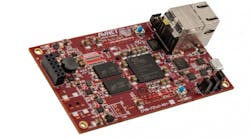Electronics distributors are clamoring to add more tools to their service offerings these days. Many are focused on satisfying growing demand for more affordable development kits and software programs that allow engineers to speed the design process and bring their ideas and products to market even faster. Low-cost development boards and more affordable computer-aided design (CAD) software programs are among the newest offerings from some of the largest distributors in the market.
The “maker” market is having a key influence on the trend, as engineering parents and weekend warriors are realizing the potential use of starter development kits in the workplace, not just in the home. Many experts say the trend will only grow as prices come down and more suppliers enter the market, and they point to a broader trend toward finding newer, smarter, and more affordable tools of all kinds to speed the design process.
“I think Raspberry Pi set everything on its side by coming up with an under $35 board that you can actually do something with,” says Andrea Koritala, global head of technology integration and strategic programs for Newark element 14, referring to the credit-card sized device introduced by the Raspberry Pi Foundation in 2012. The product was designed to get kids interested in computer programming.
“You can plug it in, put a screen up to it, and your kids can play Minecraft. Parents started to say, ‘I can probably use this in my job,’” Koritala says. “And now, major semiconductor companies are starting to pick up on it, and you’re starting to see all kinds of products on the market.”
From The Basement To The Production Line
Koritala says demand for low-cost development boards first moved from the hobbyist to the consumer space. But now distributors are finding growing demand in industrial markets, where engineers say the products are helping reduce design costs, especially as the products get more advanced, with more highly integrated functionality.
“Having a low-cost board with simple, easy, lower-cost software gets you through the cycle faster at a lower price point,” she explains. “Within the last six months the response has been explosive in relation to where we were a year or two ago.”
The lower price point is a key issue.
“A lot of people think that the simplest board that can get you the furthest the quickest should be at a realistic price point,” she says. “So, that cycle of learning is quicker and less expensive.”
Semiconductor manufacturers are responding with a variety of new offerings. Koritala points to development boards from Texas Instruments, Freescale, and Atmel as some of the more successful products on the market. TI’s BeagleBone Black, for instance, is an open-source, community-supported development platform for ARM Cortex-A8 processor developers and hobbyists that sells for around $45. Freescale’s RIoTboard is an open-source, single-board platform based on the i.MX 6Solo processor using ARM Cortex-A9 architecture, also aimed at the designer and hobbyist alike. It sells for around $75.
“You look at those key players … and they’ve already started to come out with products and set up their own communities and user groups,” Koritala says. “Their parent companies truly see this as a way to speed their time to the embedded space. And they’re picking up on the fact that professional people are playing with this [technology] and are finding new ways to use it in the market.”
Avnet Electronics Marketing is responding to the dev kit demands as well, particularly as they relate to industrial markets, says vice president of global technical marketing Jim Beneke.
“Avnet’s strong spot is the industrial segment, and that is a sweet spot for this type of activity mainly because of the volumes you’re talking about,” Beneke says. “In industrial markets, there are hundreds and thousands of units [produced]. People are thinking more about buying boards for some [of this work].”
Avnet has responded with new offerings of its own, one of which is the MicroZed Evaluation Kit, which comes with a MicroZed board, a Micro USB cable, a 4-Gbyte uSD card, a Xilinx Vivado Design Edition license voucher, and a Getting Started Card for $199. The MicroZed community, which includes Avnet and more than a dozen of its supplier partners, supports the kit and all related products. Beneke emphasizes the key role the Internet is playing in the growing trend toward boards and embedded solutions.
“The Internet is enabling the collaboration and sharing of ideas more so than in the past,” Beneke explains. “It’s really creating a sense of community and further driving growth.”
Software Demand Grows
Software is the other big piece of the development kit equation. Beneke points to Avnet’s Embedded Software Store as a prime example of the distributor’s efforts to address the growing need. The store is a marketplace for software vendors, device manufacturers, and design engineers.
“We’re seeing increasing demand for software and software support,” explains Beneke. “That’s why we created the Embedded Software Store, where customers can find software and [related tools].”
A “plug and play” design process is another factor.
“The other thing we’re seeing is that customers are saying, ‘I can try to design this all from scratch or I can buy part of the hardware—the make versus buy decision,” adds Beneke. “That’s one of the reasons we’ve offered system-on modules (SOMs). These are board solutions Avnet has created with the idea that customers would buy these as embedded products.”
Avnet offers a MicroZed SOM, for instance, that can be used with or without the MicroZed Evaluation Kit.
“Another thing that’s really interesting is the speed at which these things are coming together,” notes Beneke. “An idea pops up, they quickly get hardware, leverage open-source software and a community, and very quickly get something up and going. It’s just compressing the whole design and production schedule.”
And that presents new business opportunities to distributors such as Avnet, especially among entrepreneurs.
“It gives us an opportunity to engage with startups, a lot [of which] don’t have experience with logistics and supply chain. Avnet can help with that,” Beneke says. “It’s a way for Avnet to develop a presence with these startups and help them very early on. It gives us the ability and early access to new customers and new markets.”
Getting Into The CAD Game
Taking a bold stepto bring high-quality design software to electronics designers , Digi-Key Corp. has teamed up with electronic design software solutions company Mentor Graphics to create an affordable Computer Aided Design (CAD) software program for engineers at all levels. The companies announced a beta launch of the new Designer Schematic tool in May, with the full release slated for June.
According to Digi-Key director of applications engineering Randall Restle, the tool gives beginningengineers and established professionals alike greater access to a high-quality electronic design automation (EDA) program at an entry-level price point. Designer Schematic is available for less than $300 and allows easy migration to Mentor Graphics’ existing high-end product family that includes DX Designer (for schematics) and PADS (for PCB layout)industry standard packages.
“[Designer Schematic] is at a very attractive price point people can afford,” says Restle. In addition to the low cost, Restle points to the freedom and flexibility of Designer Schematic.“Like personal computers untethered engineers from mainframe and mini computers, Designer Schematic untethers designers from approved parts lists and tedious component data entry, symbol, and foot print generation. This allows engineers to focus on the design with less overhead to speed the time from concept to production.”
Restle adds that the overriding, guiding principle is first-pass success.
“On one hand you have the [free] online tools. On the other hand, you have the professional tools that cost thousands of dollars,” he says. “Now, there’s something in between with the freedom and flexibility that allows the engineer to do what he or she does best.”
Restle says he expects the market for these solutions to grow considerably in the next few years, and it’s a void that design-focused distributors such as Digi-Key are perfectly positioned to fill.
“You’ve not seen anything yet. There is a lot coming,” he says. “Our job is to know the latest technology in many forms and to have it in stock for leading edge designers to exploit. CAD tools are essential to engineers to make the one part we don’t offer: their circuit board. Digi-Key wants to be everywhere engineers go to pick their parts.”










